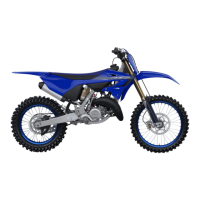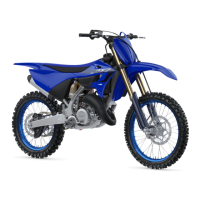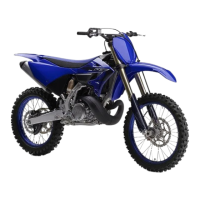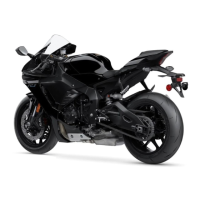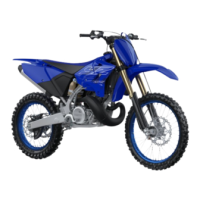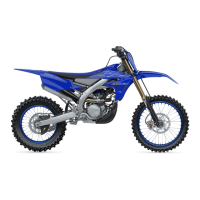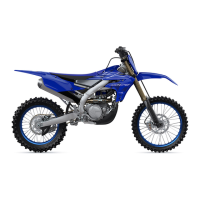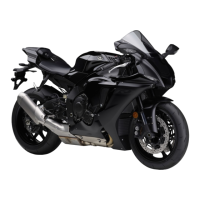Do you have a question about the Yamaha YZ125X 2022 and is the answer not in the manual?
Symbol used to alert to potential personal injury hazards. Obey all safety messages that follow this symbol.
Indicates a hazardous situation which, if not avoided, could result in death or serious injury.
Special precautions that must be taken to avoid damage to the vehicle or other property.
Provides key information to make procedures easier or clearer.
Illustrates parts and procedures with diagrams for removal and disassembly steps.
Accompanies diagrams, detailing job order, parts, and notes for procedures.
Symbol indicating serviceability with the engine in mounted position.
Symbol indicating the process of adding fluid to the vehicle.
Symbol indicating where lubrication is required for parts.
Symbol indicating the use of a specific tool for a procedure.
Symbol indicating the specified torque value for fasteners.
Symbol indicating wear limits or clearance specifications for parts.
Symbol indicating engine oil or its specification.
Symbol indicating that a part should be replaced with a new one.
Essential safety guidelines for operating the vehicle.
Information on the placement and meaning of important warning labels on the vehicle.
Description and identification of major vehicle components and controls.
Details on how to identify the vehicle and its engine serial numbers.
Lists and describes the tools and parts included with the vehicle.
Important information and precautions regarding vehicle service and maintenance.
Basic procedures and information related to vehicle servicing.
Lists specialized tools required for specific maintenance and adjustments.
Explanation of the functions and operation of various instruments and controls.
Procedures for starting the engine and the initial break-in period.
Comprehensive maintenance checks for the engine and chassis after break-in.
Procedure for cleaning and maintaining the air filter element.
Torque specifications for frame construction related fasteners.
Torque specifications for engine mounting fasteners.
Torque specifications for seat mounting fasteners.
Torque specifications for steering related fasteners.
Torque specifications for suspension components.
Torque specifications for wheel mounting fasteners.
Torque specifications for brake system fasteners.
Torque specifications for fuel system fasteners.
Torque specifications for shift pedal fasteners.
Guidelines and procedures for cleaning the motorcycle to maintain its condition.
Preparation steps to take before cleaning the motorcycle.
Detailed instructions for cleaning different parts of the motorcycle.
Critical safety instructions and responsibilities for the owner and operator.
Essential practices for safe motorcycle operation and pre-ride checks.
Importance and types of protective apparel for motorcycle riders.
Precautions to avoid carbon monoxide poisoning from exhaust fumes.
Information regarding genuine Yamaha accessories and their benefits.
Guidance on aftermarket parts and modifications, and potential risks.
Information on the appropriateness of aftermarket tires and rims.
Instructions and precautions for safely transporting the motorcycle.
Identification of the clutch lever and its function.
Identification of the engine stop switch and its function.
Identification of the front brake lever and its function.
Identification of the throttle grip and its function.
Identification of the radiator cap and its function.
Identification of the fuel tank cap and its function.
Identification of the kickstarter lever and its function.
Identification of the fuel tank and its function.
Identification of the radiator and its function.
Identification of the coolant drain bolt and its function.
Identification of the transmission oil level check bolt.
Identification of the rear brake pedal and its function.
Identification of the valve joint and its function.
Identification of the fuel cock and its function.
Identification of the air filter and its function.
Identification of the drive chain and its function.
Identification of the shift pedal and its function.
Identification of the starter knob (choke) and its function.
Identification of the front fork and its function.
Information on the location of the Vehicle Identification Number (VIN).
Information on the location of the engine serial number.
Description and use of the included nipple wrench for spoke tightening.
Description of the valve joint and its installation on the fuel tank breather hose.
Description of the collar used for YPVS system service.
Essential preparation steps before starting removal and disassembly procedures.
Recommendation to use new Yamaha genuine and recommended parts for repairs.
Procedures for replacing and installing gaskets, oil seals, and O-rings during overhaul.
Guidance on replacing and using lock washers, plates, and cotter pins.
Instructions for installing bearings and oil seals correctly.
Guidelines for correctly installing circlips during assembly.
Information and procedures for checking and servicing the electrical system.
Details of the digital circuit tester and its part number for ordering.
Details of the steering nut wrench and its part number for ordering.
Details of the spoke nipple wrench and its part number for ordering.
Details of the dial gauge and stand set and their part numbers.
Details of the cap bolt ring wrench and its part number for ordering.
Details of the cap bolt wrench and its part number for ordering.
Details of the fork seal driver and its part number for ordering.
Details of the piston pin puller set and its part number for ordering.
Details of the rotor holding tool and its part number for ordering.
Details of the flywheel puller and its part number for ordering.
Details of the clutch holder and its part number for ordering.
Details of the thickness gauge and its part number for ordering.
Details of the heavy duty flywheel puller and its part number for ordering.
Details of Yamaha bond No. 1215 used for sealing.
Details of the radiator cap tester and its part number for ordering.
Details of the radiator cap tester adapter and its part number for ordering.
Details of the fuel level gauge adapter and its part number for ordering.
Details of the fuel level gauge and its part number for ordering.
Details of the ignition checker and its part number for ordering.
Location and operation of the engine stop switch.
Explanation of the shift pedal operation and gear selection.
Operation of the kickstarter lever for starting the engine.
Location and operation of the front brake lever.
Location and operation of the rear brake pedal.
Description of the fuel cock positions and their functions.
Operation of the starter knob (choke) for cold engine starting.
Function and use of the sidestand.
Specifications for mixing fuel and engine oil, including recommended ratios.
Step-by-step procedure for starting a cold engine.
Procedure for starting a warm engine.
Recommended procedures for the engine break-in period to ensure proper fitment.
Comprehensive maintenance checks for the engine and chassis after break-in.
Procedure for cleaning and maintaining the air filter element.
Torque specifications for frame construction related fasteners.
Torque specifications for engine mounting fasteners.
Torque specifications for seat mounting fasteners.
Torque specifications for steering related fasteners.
Torque specifications for suspension components.
Torque specifications for wheel mounting fasteners.
Torque specifications for brake system fasteners.
Torque specifications for fuel system fasteners.
Torque specifications for shift pedal fasteners.
Guidelines and procedures for cleaning the motorcycle to maintain its condition.
Preparation steps to take before cleaning the motorcycle.
Detailed instructions for cleaning different parts of the motorcycle.
Cleaning procedures after normal operation of the motorcycle.
Special cleaning procedures for riding in corrosive environments.
Steps to follow after cleaning the motorcycle to protect it.
Recommendations for storing the motorcycle for short and long terms.
General physical dimensions, weight, and capacity of the vehicle.
Detailed technical specifications for the engine components and systems.
Detailed technical specifications for the chassis components and systems.
Technical specifications for the vehicle's electrical system.
Comprehensive list of torque specifications for various fasteners and components.
Diagrams illustrating the correct routing of cables and wires on the vehicle.
General tightening torque specifications for standard fasteners.
Specific torque values for engine component fasteners.
Specific torque values for chassis component fasteners.
Schedule outlining regular maintenance checks and intervals for the vehicle.
Essential inspections and maintenance before operating the vehicle.
Procedures for engine checks and adjustments.
Procedures for chassis checks and adjustments.
Procedures for checking and maintaining the electrical system.
General inspection and maintenance checks to perform before riding.
Procedure for adjusting the pilot air screw for fuel-air mixture.
How to check and adjust the engine's idling speed.
Procedure for checking and adjusting the throttle grip free play.
Steps for checking the spark plug condition and gap.
Procedure for checking the transmission oil level.
Steps for draining and refilling the transmission oil.
How to adjust the clutch lever free play for optimal operation.
Procedure for adjusting the clutch lever position.
Instructions for cleaning the air filter element.
Check for cracks or damage in the carburetor joint.
Inspect fuel and vacuum hoses for cracks, damage, or loose connections.
Inspect the exhaust pipe and silencer for cracks, damage, or fiber wear.
Procedure for checking the coolant level in the radiator.
Inspect the radiator, hoses, and other cooling system components.
Steps for draining and refilling the engine coolant.
Procedure to adjust the front disc brake lever position.
Procedure to adjust the rear brake pedal position.
How to check the brake fluid level in the reservoir.
Inspecting the front brake pads for wear using indicator grooves.
Inspecting the rear brake pads for wear using indicator grooves.
Check the front brake hose for cracks, damage, or wear.
Check the rear brake hose for cracks, damage, or wear.
How to check the overall brake operation for responsiveness.
Procedure for bleeding the hydraulic brake system to remove air.
Procedure for checking and adjusting the ignition timing.
General overview and procedures related to the chassis.
Procedures for removing, disassembling, checking, and installing the front wheel.
Procedures for removing, disassembling, checking, and installing the rear wheel.
Detailed procedures for servicing the front brake system components.
Detailed procedures for servicing the rear brake system components.
Procedures for removing, checking, and installing the handlebar.
Procedures for removing, disassembling, checking, assembling, and installing the front fork.
Procedures for removing, checking, and installing the steering head assembly.
Procedures for handling, removing, checking, and installing the rear shock absorber.
Procedures for removing, checking, and installing the swingarm.
Procedures for removing, checking, and installing the drive chain and sprockets.
Steps for removing the seat and side covers from the chassis.
Steps for removing the front wheel from the motorcycle.
Steps for removing the rear wheel from the motorcycle.
Steps for removing the front brake caliper assembly.
Introduction to disc brake component disassembly and precautions.
Checking the front brake disc for thickness and runout.
Procedure for replacing the front brake pads without disconnecting the hose.
Steps for removing the front brake caliper.
Disassembly of the front brake caliper.
Inspection of caliper piston, cylinder, body, and passages.
Assembly of the front brake caliper components.
Steps for removing the front brake master cylinder.
Inspection of the master cylinder, reservoir cap, diaphragm, and hose.
Assembly of the front brake master cylinder components.
Steps for removing the rear brake caliper assembly.
Introduction to disc brake component disassembly and precautions.
Checking the rear brake disc for thickness and runout.
Procedure for replacing the rear brake pads.
Steps for removing the rear brake caliper.
Disassembly of the rear brake caliper.
Inspection of caliper piston, cylinder, body, and passages.
Assembly of the rear brake caliper components.
Steps for removing the handlebar from the vehicle.
Steps for removing the front fork legs from the triple clamps.
Steps for removing the lower triple clamp assembly.
Steps for removing the rear shock absorber assembly.
Steps for removing the swingarm from the motorcycle.
Steps for removing the drive chain from the sprockets.
Procedures for removing the engine from the chassis.
Service procedures for cylinder head, cylinder, and piston assembly.
Procedures for removing, checking, and installing the CDI magneto.
Procedures for removing, checking, and installing the kickstarter mechanism.
Procedures for removing, checking, and installing the YPVS governor.
Procedures for removing, checking, and installing the clutch assembly.
Procedures for removing, checking, and installing the shift shaft.
Procedures for separating, checking, and assembling the crankcase.
Procedures for removing, checking, and installing the crankshaft.
Procedures for removing, checking, and installing the transmission components.
Steps for removing the exhaust pipe from the engine.
Steps for removing the cylinder head and cylinder assembly.
Steps for removing the CDI magneto assembly.
Steps for removing the primary drive gear.
Steps for removing the YPVS governor from the crankcase cover.
Steps for removing the clutch cover and components.
Steps for removing the shift shaft and stopper lever.
Steps for separating the crankcase halves.
Steps for removing the crankshaft assembly from the crankcase.
Steps for removing the transmission, shift drum, and forks.
Diagrams illustrating the cooling system components and layout.
Procedures for removing and installing the radiator.
Procedures for disassembling, checking, and assembling the water pump.
Steps for removing the radiator assembly from the vehicle.
Steps for removing the water pump housing and components.
Procedures for removing the fuel tank.
Procedures for removing the air filter element.
Procedures for handling, checking, assembling, and installing the carburetor.
Schematic diagram of the vehicle's electrical system wiring.
Explanation of color codes used in the wiring diagram.
Troubleshooting guide for ignition system issues like no spark.
General troubleshooting steps for ignition system problems.
Procedures for checking various electrical components.
Explanation of color codes used in the wiring diagram.
Troubleshooting guide for ignition system problems like no spark.
Checking the engine stop switch for proper function.
Checking the CDI unit for faults.
Checking the ignition coil for proper resistance.
Procedure for checking switch continuity using a digital circuit tester.
How to check and adjust the ignition spark gap.
Checking the spark plug cap resistance.
Checking the primary and secondary coil resistance.
Checking the pickup coil resistance.
Checking the source coil resistance.
General information and guidance for using the troubleshooting section.
Troubleshooting guide for engine starting and running issues.
Troubleshooting guide for clutch performance issues like slippage or drag.
Troubleshooting guide for transmission shifting and noise problems.
Troubleshooting guide for cooling system issues like overheating.
Troubleshooting guide for brake system performance issues.
Troubleshooting guide for suspension performance issues.
Troubleshooting guide for steering and handling problems.
Troubleshooting guide for engine starting issues: no spark or fuel supply problems.
Possible causes and actions for low engine compression pressure.
Troubleshooting for incorrect idling speed or mid-to-high speed performance issues.
Troubleshooting for engine issues at mid-high speeds.
Troubleshooting guide for noises originating from the engine.
Possible causes and actions for clutch slippage.
Possible causes and actions for clutch drag.
Troubleshooting for shifting difficulties or impossibility.
Troubleshooting for transmission gears jumping out of engagement.
Troubleshooting guide for noise originating from the transmission.
Troubleshooting steps for engine overheating issues.
Troubleshooting guide for noise originating from the water pump.
Troubleshooting for poor disc brake performance.
Troubleshooting for a stiff front fork.
Troubleshooting for oil leaks from the front fork.
Troubleshooting for a stiff rear suspension.
Troubleshooting for a soft rear suspension.
Troubleshooting for oil leaks from the rear shock absorber.
Troubleshooting for handlebar wobble.
Troubleshooting for heavy steering.
Troubleshooting for front wheel vibration.
Troubleshooting for rear wheel vibration.
Tuning procedures for the engine, primarily carburetor adjustments.
Detailed guide on setting the carburetor for optimal performance.
How atmospheric conditions affect carburetor settings.
Procedure for test running the vehicle after tuning.
How different parts affect throttle valve opening and mixture.
Adjusting the main jet for optimal air-fuel mixture.
Adjusting the pilot air screw for low-speed mixture.
Adjusting the pilot jet for low-speed mixture enrichment.
Adjusting the jet needle for intermediate speed operation.
Adjusting the jet needle clip position to fine-tune intermediate speed mixture.
How fuel flow is regulated by jet needle settings at different throttle openings.
List of parts used for carburetor setting and their specifications.
Carburetor setting examples based on road conditions and symptoms.
Detailed specifications for various jet needles.
Troubleshooting and setting examples based on engine symptoms.
Changing spark plug heat range as part of engine tuning.
Tuning procedures related to the chassis and suspension.
Guidance on selecting the appropriate secondary reduction ratio for optimal performance.
Specifications for drive and rear wheel sprockets.
Adjusting tire pressure for optimal performance based on conditions.
Adjusting front fork settings for rider preference and conditions.
How fork oil amount affects damping and performance.
Setting the front fork spring after replacement for proper balance.
Specifications for front fork springs, including part numbers.
Adjusting rear suspension preload and damping.
Procedure for measuring and setting the spring length.
Setting the rear suspension spring after replacement.
Specifications for rear shock absorber springs.
Detailed guide to adjusting front fork settings for various symptoms.
Detailed guide to adjusting rear shock absorber settings for various symptoms.
Explanation of the carburetor's role and the importance of proper air-fuel mixture.
How air density, affected by temperature, humidity, and pressure, influences mixture settings.
Procedure for test running the engine and checking spark plug condition.
How main jet, pilot air screw, and pilot jet affect mixture at different throttle openings.
Adjusting the main jet for optimal air-fuel mixture.
Adjusting the pilot air screw to control low-speed mixture.
Adjusting the pilot jet for low-speed mixture enrichment.
Adjusting the jet needle for intermediate speed operation.
Adjusting the jet needle clip position to fine-tune intermediate speed mixture.
How fuel flow is regulated by jet needle settings at different throttle openings.
Changing spark plug heat range as part of engine tuning.
Guidance on selecting the appropriate secondary reduction ratio for optimal performance.
Specifications for drive and rear wheel sprockets.
Adjusting tire pressure for optimal performance based on conditions.
Adjusting front fork settings for rider preference and conditions.
How fork oil amount affects damping and performance.
Setting the front fork spring after replacement for proper balance.
Procedure for measuring and setting the spring length.
Setting the rear suspension spring after replacement.
Adjusting front fork settings for stiff performance over the entire range.
Adjusting front fork for unsmooth movement across the entire range.
Adjusting front fork for poor initial movement.
Adjusting front fork for soft performance and bottoming out.
Adjusting front fork for stiffness towards the end of the stroke.
Adjusting front fork for softness and bottoming out towards stroke end.
Adjusting front fork for stiff initial movement.
Adjusting rear suspension to correct low front posture.
Adjusting rear suspension for "obtrusive" front posture.
Adjusting rear suspension for stiffness and sinking.
Adjusting rear suspension for spongy and unstable feel.
Adjusting rear suspension for heavy and dragging feel.
Adjusting rear suspension for poor road grip.
Adjusting rear suspension to prevent bottoming out.
Adjusting rear suspension to reduce bouncing.
Adjusting rear suspension for stiff travel.
| Bore x Stroke | 54.0mm x 54.5mm |
|---|---|
| Ignition | CDI |
| Transmission | 6-speed; multiplate wet clutch |
| Final Drive | Chain |
| Front Suspension | KYB® Speed-Sensitive System inverted fork; fully adjustable, 11.8-in travel |
| Rear Suspension | KYB® single shock; fully adjustable, 12.4-in travel |
| Front Brake | Hydraulic disc, 270mm |
| Width | 32.5 in |
| Wheelbase | 58.3 in |
| Fuel Capacity | 2.1 gal |
| Engine Type | Liquid-cooled, 2-stroke, reed-valve inducted |
| Fuel Delivery | Mikuni® TMX 38 |
| Rear Brake | Hydraulic disc, 245mm |
| Front Tire | 80/100-21 |
| Rear Tire | 110/100-18 |

